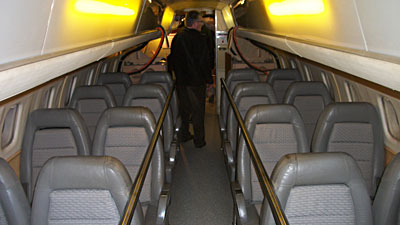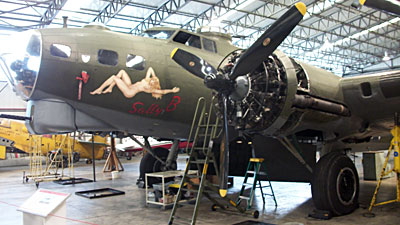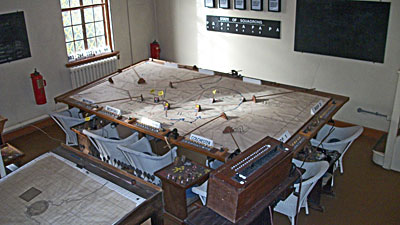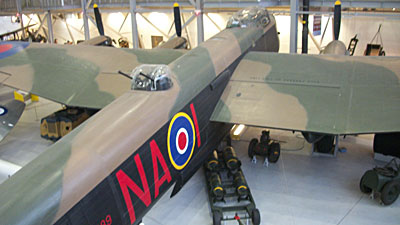| Photos by Pat Murphy |
 The ROMEOs at Stansted Airport |
| Retired Old Men should not be getting up at 5 in the morning. However, Gerry O'Neill's ROMEOs did just that on Tuesday 12th November when they took to the air with Ryan Air. The day began with most assembling at the Yacht Club where two taxis transported them to the Airport to join the rest of the 23 GROUPIES plus guest; the recently young retired Club Bar Manager John Bennett, in preparation for the flight to Stansted to visit the Duxford Air Museum. |
 Boarding the bus at Standsted Airport for Duxford |
| After arrival in Stansted we were transported by pre-arranged bus, that we had for the day, to the Museum where we arrived at 10:30. The Museum is situated on a former first and Second World War RAF base. Much of the original RAF station is preserved. In 1924 Duxford became a fighter station, a role it was to carry out with distinction for 37 years. In February 1940 one of the heroes of the Second World War was posted to No.19 Squadron at Duxford. Flying Officer Douglas Bader had lost his legs in an air crash several years earlier and had been discharged from the RAF. He would not permit his artificial limbs to deter him and soon showed himself to be a fine RAF pilot and leader during WW2. |
 A view of part of Museum area |
| In April 1943 the airfield was handed over to the United States Air Force and Duxford now became Base 357 and the headquarters of the 78th Fighter Group. The first RAF aircraft to return to Duxford after the war were Spitfires, soon to be replaced by Gloster Meteors. In July 1961 the last operational RAF flight was made from Duxford and for some 15 years the future of the airfield remained in the balance. However, the Imperial War Museum had been looking for a suitable site for the storage, restoration and eventual display of large exhibits and obtained permission to use the airfield. Today Duxford is established as the European centre of aviation history. |
 Concord with Lancaster in foreground |
 Inside Concord |
| A visit to Duxford is simply a must for any aviation enthusiast, and the atmosphere is only enhanced by the activity on the working airfield and the sound of piston engines from the Tiger Moths, Spitfires and Dragon Rapides is constantly heard overhead. While there we saw and heard some of these piston engined aircraft take off, fly overhead and land. An example of some of the various exhibition hangers includes; Flying Aircraft: This display covers two hangers exploring two former RAF Type 2 hangars where some of the privately-owned historic aircraft are restored, maintained and prepared for flight. |
 Flyer, Virgin Atlantic's Hot-Air baloon Capsule |
 Flyer, Virgin Atlantic Flyer |
| Conservation in Action: Where a team of dedicated staff and volunteers care for hundreds of unique exhibits. Much of this vital work is carried out in full view of visitors. |
 Mechanic at work |
 A mobile workshop |
| Battle of Britain: This exhibition looks at this pivotal moment in Britain's history as well as considering air defence of the UK during the First World War and the Cold War. AirSpace: The Air Space display tells the story of aviation in Britain and the Commonwealth, featuring over 30 iconic aircraft including Concorde and the Spitfire. |
 The smallest of the fleet of civilian vessels which crossed the Channel to take part in the Dunkirk evacuation |
| The American Air Museum: The American Air Museum stands as a memorial to the 30,000 American airmen who gave their lives flying from UK bases during the Second World War, and also honours those who fought in Korea, Vietnam, Libya, Iraq and other conflicts and battles of the twentieth and twenty-first centuries. |
 American aircraft factory during World War Two |
| Air and Sea: As an island, Britain's control of the sea was vital to its defence. The Air and Sea exhibit shows the changes in defence methods, from the giant battleships of the First World War to modern-day submarines and aircraft carriers. |
 Boeing B-52D Stratofortress, wing span 185 ft and length 156 ft |
 Memphis Belle |
 Sally B |
| Operations Room: |
 Reconstructed Operations Room |
| A reconstructed 1940 Operations Room, which directed aircraft in the Battle of Britain. I found this reconstruction to be most interesting. The various display hangers cover a distance of a mile from the entrance and it is true to say that some, or perhaps most of the ROMEOs were showing signs of their age by days end. |
 Heinkel He 162 A-2 Salamander. A German fighter produced towards the end of the Second World War |
| On leaving the Museum we travelled the short distance to Whittlesford Bridge where we had a very nice meal with the compulsory liquid to wash it down in the Red Lion Inn. During the meal our Chief ROMEO Gerry O'Neill made a presentation to John Bennett. Joining us for the meal was Ralph Murphy a friend of Cyril Geran and Frank Cole. Cyril crossed the Atlantic and sailed in the Mediterranean with him. It was Ralph who introduced Cyril to the Museum previously and as a result Cyril recommended it to the ROMEOs. |
 London bus which was used on the Western Front during World War One |
 Gerry O'Neill making presentation to John Bennett |
| The day ended when Ryan Air returned 24 very slow moving and tired individuals back to Dublin at 21:40 hours. Without the "very special" return airfare obtained from Ryan Air we would not have been able to embark on such a memorable day. In summary it was a most enjoyable and well organised day by the two Gerry's, O'Neill and Sargent, well done lads. |
 The Shackleton MR3, airborne early warning aircraft |
| The ROMEOs final outing of 2013 will be their planned visit shortly to the Maritime Museum in Dun Laoghaire followed with their Christmas lunch in the National Yacht Club. |
 A McDonnell Douglas F-15, fronted by John Tiernan, Derek Bothwell & Wally McGuirk |
 Lancaster |